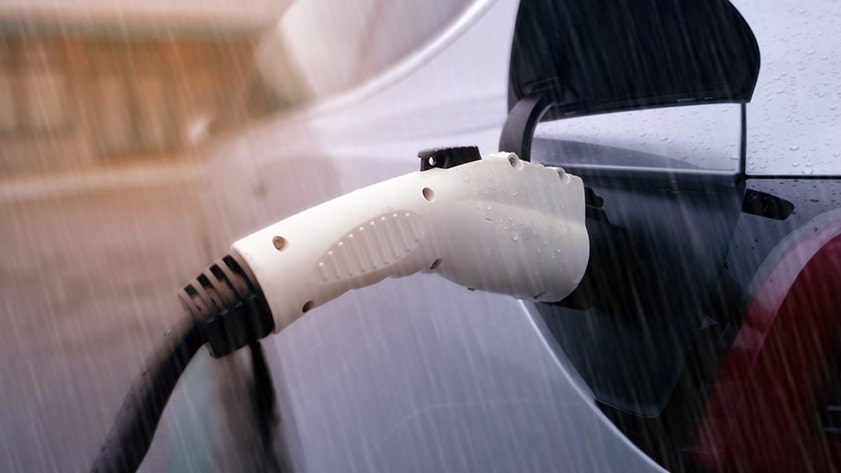Can I Charge My EV in the Rain?

Singing in the rain may be glorious but charging in the rain seems dicey. Could the reason for California’s dominance in EV ownership be the sunny climate?
The straight answer is No!—charging an EV in the rain or almost any other kind of weather is perfectly safe. Still, expecting danger isn’t so farfetched. We know that water conducts electricity and are hardwired to shrink from mixing the two. So, standing on wet pavement while plugging a charging cord into an EV may not seem like the best practice. You may conjure up a slew of disastrous outcomes, from sparks to shocks to short circuits to electrocution.
But that’s not what happens. Let’s take a closer look at how charging an EV in the rain works.
EV Charging Safeguards
To recharge the battery that powers your EV motor, you connect the charging port of your EV to a wall outlet or EV charging station with the supplied charging cord. But nothing happens until the charging station and EV establish communications. Then, the EV conducts measurements to ensure everything is good to go. For example, the charging cord won’t be energized if the vehicle isn’t plugged in. Once the EV determines it’s safe to proceed, then current will flow. The EV monitors the charging itself and stops the flow if there’s a disruption.
EV Charging Indoors and Out
Most EV owners charge their vehicles in the evening, after they return from work—and 85% of the time, that activity occurs in single-family homes with dedicated parking, according to the U.S. Department of Energy. In your garage, hardwired home charging provides a watertight connection capable of handling rain, snow, sleet, and hail. But even if you have only a carport or parking space, a hardwired charging station is a safe option for outdoor use.
What happens if it’s raining or snowing? It’s business as usual. Of course, you don’t want the charging plug to be sitting in water or the charging port to be covered with snow. But otherwise, both the EV and EV charging station are designed for just about any kind of weather—except for floods and hurricanes. They’re also tested to standards set by the Society of Automotive Engineers.
EV and Charging Station Ingress Protection
Engineers design EVs to manage water, rain, dust, and other particles that could interfere with the electrical system. They’re also rated to show how well they withstand intrusion. The Ingress Protection rating—or IP for short—has two numbers. Consider Audi e-tron models—they have an IP rating of 67. The first number, 6, indicates how well the EV prevents dirt or dust from getting into the device. The scale for solid particles is 1-6, so the Audi e-tron protects as well as any device. For liquids, the scale runs from 1-8, but the e-Tron rates only a 7. Why no better? The higher number is generally for submersible equipment like buoys or oceanographic equipment. But to earn a rating of 7 means that every EV component, including electrical components, can withstand submersion in water at 1 meter for 30 minutes.
That’s fine for the EV, but what about the charging station? Most Level 2 charging stations like the Enel X JuiceBox have an IP rating of 44. That means they can withstand intrusion by dirt and dust particles larger than 1 millimeter and splashing water, like horizontal rain.
Charging Station Regulations
The National Electrical Code (NEC) determines regulations for charging stations and installations. The charging stations themselves must meet safety standards from the Underwriters Laboratory (UL). All JuiceBox charging stations meet the safety requirements of NEC Article 625 and UL 2594. The Enel X JuiceBox charging stations also meet NEMA-4 standards. This includes a gasketed door enclosure for indoor or outdoor use, which provides a degree of protection against windblown dust and rain, splashing water, hose-directed water, and ice that forms on the enclosure.
When you need to power up on the road, you’ll turn to a public Level 3 fast charging station. Again, the fact that you’re using DC fast charging current instead of AC makes no difference in inclement weather—these stations are also tested to ensure you’re not taking a risk in rain or snow. Commercial stations are hardwired and rigorously tested to protect you, your car, and their equipment.
Advice for the Weather Wise
No matter what kind of vehicle you’re in, you shouldn’t venture through floods or during hurricanes or blizzards. If you’re receiving alerts that any of these events could occur, you should charge up your vehicle immediately, before the power goes out or you need to evacuate. Also, download apps and information for public charging station locations along your route.
We hope most days find you under sunny skies. But to borrow from the U.S. Postal Service, neither snow nor rain nor heat nor gloom of night should keep you from charging your EV.






